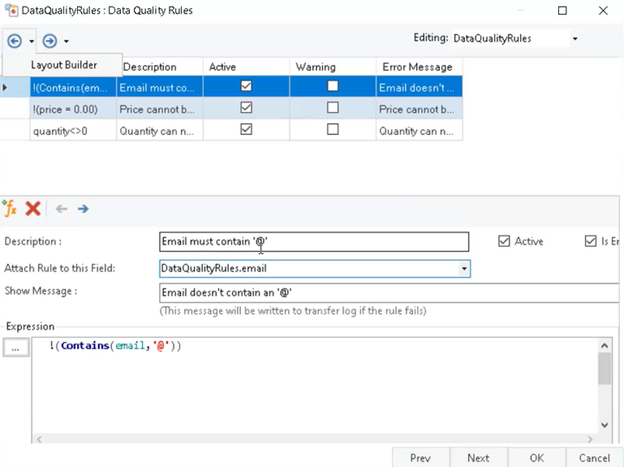
Effortlessly ETL Data from MongoDB to SQL Server
MongoDB is an ideal database to handle the explosive growth in unstructured data. The non-relational nature of the database allows excellent back-end support for applications related to the Internet of Things, content management, e-commerce, and more. However, when it comes to applications that rely on structured data with high referential integrity, such as financial applications, a relational database such as SQL Server is a better option.
Businesses often use MongoDB and SQL Server together, requiring seamless data transfer between the two databases. A code-free ETL tool with native connectivity to these databases can simplify the transfer.
In this blog, we have discussed the specifications of both databases and how you can effortlessly ETL data from MongoDB to SQL Server using Astera Centerprise.
Is MongoDB No SQL?
MongoDB is a NoSQL database used as an alternative to SQL databases such as PostgreSQL and SQL Server. A NoSQL database stores data in a non-tabular format without schema.
There are different NoSQL databases, such as document-based, key-value, wide-column, and graph. MongoDB is a document-based database.
Data comes in all formats these days. MongoDB allows you to store vast volumes of unstructured and semi-structured data without defining its schema while writing. As a result, you can store all data in its raw format without restricting it to a table and sacrificing the details.

A sample of MongoDB Structure
Pros and Cons of MongoDB
NoSQL databases are suitable in fast-paced environments, where a business must deal with high volumes of unstructured data. The schema-less nature of these databases makes them highly flexible and allows you to make changes quickly, so you can continuously add new features to your application.
A noteworthy feature of MongoDB is that it can scale horizontally, which means you can add more servers at a low cost to increase its capacity.
Moreover, data stored in MongoDB is optimized for easier accessibility. Since the queries don’t require any like in a relational database, you can quickly retrieve data.
Some use cases warrant NoSQL databases; however, for use cases with complex analytical needs, NoSQL databases are not suitable.
Since MongoDB doesn’t support complex queries and join functions, developers must write complex codes to run complex analytical queries. Also, there are no relations defined in MongoDB, which often leads to data duplication.
Why Use SQL Server?
When developers need to run complex queries on their data, they add a layer of a relational database such as SQL Server. SQL Server stores and retrieves data in a tabular form, so you can easily access data and make changes using Insert, Update, and Delete commands.
The database supports Join command and conditional statements and is a good choice for running complex analytical queries. In addition to that, SQL Server comes with a host of analytical tools that make it easier for users to conduct analyses on their data.
In SQL Server, multiple tables can be interrelated with the help of a primary key. It minimizes the risk of errors and data duplication while ensuring the accuracy and reliability of the information in the database. SQL Server also allows an efficient way of storing and managing data through normalization. Normalization breaks down information into sizeable chunks, keeping data integrity intact and ensuring there is no variance in the structure.
How to ETL data from MongoDB to SQL Server
You can transfer MongoDB data to SQL Server through SSIS or by writing extensive codes. However, there are certain limitations associated with these methods. With the manual approach you have to:
- Rely heavily on your IT team when you transfer data from MongoDB to SQL Server since it involves a lot of coding.
- Manually build and maintain each data pipeline to integrate your MongoDB data with other sources.
- Deal with the hierarchical nature of MongoDB, which can make it tedious to manipulate and alter data.
A no-code tool such as Astera Centerprise is a more innovative way to ETL data from MongoDB to SQL Server. The tool comes with native connectors, which allow you to connect to both databases without writing any code. Using its intuitive UI and drag-and-drop environment, you can start building your data pipelines within minutes.
Here’s a closer look at how you can transfer your data from MongoDB to SQL Server with Astera Centerprise.
Data Transfer from MongoDB to SQL Server with Astera Centerprise
Let’s take a scenario. You get data from multiple sources such as social media, apps, websites, and POS systems. The data is stored in its raw format in MongoDB and then sent to SQL Server for better analysis. You can make this process seamless and faster with Astera Centerprise.
Using Astera’s Centerprise intuitive interface, you can map the data from MongoDB source to SQL Server with just a few clicks. The code-free ETL tool allows you to implement Join effortlessly and apply data quality rules, so only reliable data makes it to your target destination.

Data Pipeline from MongoDB to SQL Server in Astera Centerprise
The picture below shows a sample of data in MongoDB. The data shows several items and tags associated with a sales ID. With SQL Server, you can build a relationship between multiple entities and query data accordingly. To do this, you must flatten the data, clean it, and send it to the SQL Server destination.

MongoDB Data Structure
Connecting to MongoDB with Astera Centerprise
You can use the built-in connector for MongoDB either as a source or a destination and effortlessly integrate it with your data pipelines. With Astera Centerprise, you don’t have to worry about writing extensive codes to access data from MongoDB; just drag and drop the connector in the data flow designer and connect to the database in a few clicks.
Astera Centerprise has several functionalities to ensure the high availability of data. For example, if your data is on multiple servers, Centerprise allows load balancing. If your data is unavailable on the primary server, it will fetch data from the secondary server.
The ETL tool also gives you read preferences, allowing you to choose whether you want to read your data from a primary or secondary server.
Once connected, you can use MongoDB’s native filters to manipulate and alter data before extraction.

Connecting to MongoDB in Astera Centerprise
Connecting to SQL Server with Astera
Astera Centerprise supports native connectivity for multiple relational databases, including Microsoft SQL Server. You can connect to SQL Server just as you connect to MongoDB. Drag and drop the connector in the data flow designer, configure the properties, and you are good to go.

Connecting to SQL Server in Astera Centerprise
Join Transformation
Astera Centerprise supports various built-in transformations that allow you to manipulate your data to make it compatible with your destination. As shown previously, data stored in MongoDB is hierarchical. To serialize or flatten this data, we will use the Join transformation.
There are various items and tags associated with a particular sales ID. We will use the Join transformation and Sales_ID as the matching field to join the two datasets to find all the items associated with a particular sales ID.

Join transformation in Astera Centerprise
Once the data has been through the Join transformation, it will flatten out, so you can quickly run queries or transfer it to a relational database.

Data after applying Join transformation
Data Quality Rules
Maintaining data quality is a pertinent issue while migrating any data. Astera Centerprise comes with extensive data quality and profiling features that ensure your data is reliable down the stream.
In this scenario, we ensure that there are no null values in our data by applying three rules: price cannot be zero, quantity cannot be zero, and email should have a @ sign. Any values that do not meet these criteria will be flagged, so you can quickly rectify them.

Applying data quality rules in Astera Centerprise
Automation
You can automate your data pipelines from MongoDB to SQL Server using Astera’s automation and job scheduling features. Astera Centerprise comes with event- and time-based triggers that you can set up to run your data flows. Automation expedites your data transfers and ensures that your data is not error-ridden.
Why Astera Centerprise?
With the code-free nature and intuitive UI of Astera Centerprise, you can empower your business users to take charge of their data initiatives. Here are some reasons why you should try Astera Centerprise:
- A wide range of connectors: Astera Centerprise supports connectors for popular databases, data warehouses, and file formats. To get rich insights, you can use these in-built connectors to integrate your MongoDB data with other enterprise sources.
- Built-in transformations: Sort, filter, aggregate, or normalize/denormalize your data with Astera’s library of code-free transformations. You can alter and manipulate your data in any way you want without writing any code.
- Code-free environment: Astera’s zero-code interface makes life easier for developers and business users. There is no need to write or maintain extensive codes. It takes a few clicks to connect to MongoDB and SQL Server.
- Automation: With Astera Centerprise, you can have near real-time insights. It expedites your tasks and saves you from any manual intervention.
- Schema Management: When dealing with MongoDB, Astera automatically detects schema so that you can map it into your destination.
Simplify MongoDB ETL
Modern-day data challenges require modern solutions. MongoDB is an excellent choice for dealing with unstructured data these days. Complementing it with a code-free ETL tool ensures that you can match the fast pace required by today’s business environment. With Astera Centerprise, you can simplify MongoDB ETL and expedite your data-driven initiatives.
Download Astera Centerprise today for a 14-Day free trial.
 Astera AI Agent Builder - First Look Coming Soon!
Astera AI Agent Builder - First Look Coming Soon!



